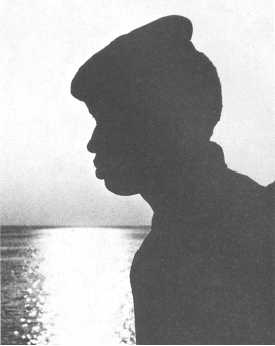Lighting
Lighting is one of the important creative elements
of composition. When you control the light and direct it
where it is wanted, minor objects or distracting elements
in the scene can be subdued and thereby give more
prominence to the main point of interest. The type of
lighting best suited for a subject depends on the type of
subject and the purpose of the photograph. If maximum
detail is desired in the shadows, the illumination should
be soft and diffused. Sidelighting is most effective in
showing texture. However, light falling diagonally on
the subject from above and to one side of the camera is
the most natural form of illumination. We are
accustomed to seeing most subjects under this condition
in which the shadows are castoff to one side and slanted
away from us, creating the greatest apparent depth and
roundness in the subject.
Shadows are the key to apparent depth in a
photograph. Without shadows the subject is without
form, curvature or texture, appearing flat and lifeless.
This does not mean that shadows should be harsh and
black to achieve these effects. They maybe soft, yet of
sufficient density to show the most delicate roundness of
form. As a general rule, harsh black shadows are
undesirable in a photograph due to the complete loss of
detail in them. From a compositional standpoint
however, black shadows can be very useful in balancing
a scene and directing attention to the point of interest.
While viewing the scene from various angles to select
the best camera position, note the effects of illumination.
In all probability, the most complimentary lighting on an
outdoor subject occurs only during one short period of
the day. For this reason, time your photograph to take
advantage of the most suitable available light or plan to
create your own illumination with auxiliary lights.
Silhouetting
Silhouetting is when a subject is backlighted and
then underexposed. A silhouetted subject gives overall
strength to a composition and isolates the subject
through contrast of the dark foreground against the
lighter background (fig. 12- 13).
COMPOSITIONAL LINES
The formation of lines in a composition is
unavoidable. For example, lines are formed by the
Figure 12-13.—Silhouetted subject.
horizon, a person’s limbs, the side of a ship, a fence or a
winding road. These lines — vertical, horizontal,
diagonal or curved — lend their own element of
emphasis to a composition.
Vertical lines formed by elements in composition
suggest strength and dignity (a sentry at attention), while
horizontal lines suggest tranquility and rest (a ship on
the horizon at sunset). The diagonal line suggests action
(climbing aircraft) and a variety of lines indicates
activity. A feeling of grace and beauty is conveyed to the
viewer by the use of curvaceous lines, such as those used
in glamour and fashion photography.
BALANCE
A good composition should have balance. In other
words, your viewer should not get the uneasy feeling
that the elements may come tumbling out of your
composition.
A balanced composition gives a feeling of harmony
to the whole setting. Elements of balance are placed in
opposing sections of a photograph in such a manner that
each section appears to have an equal amount of weight
12-15



